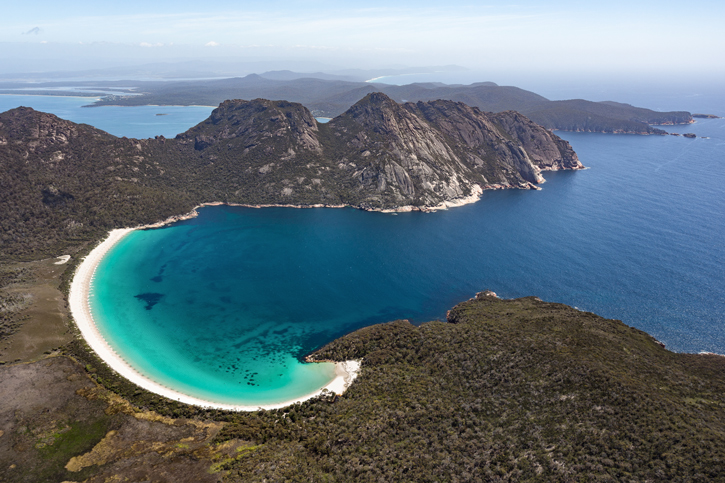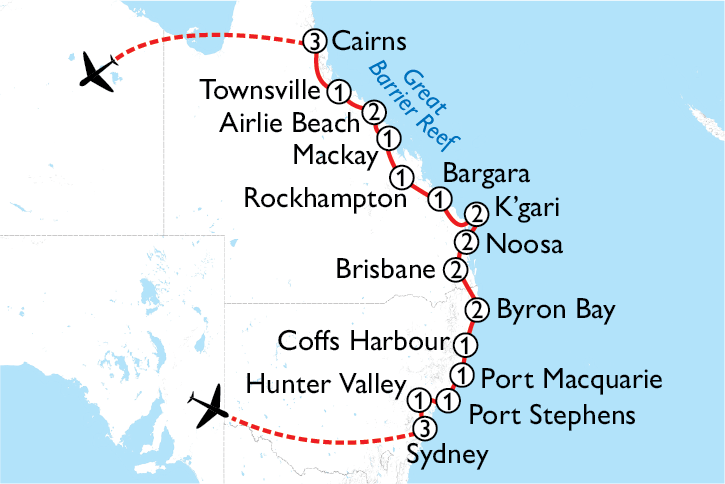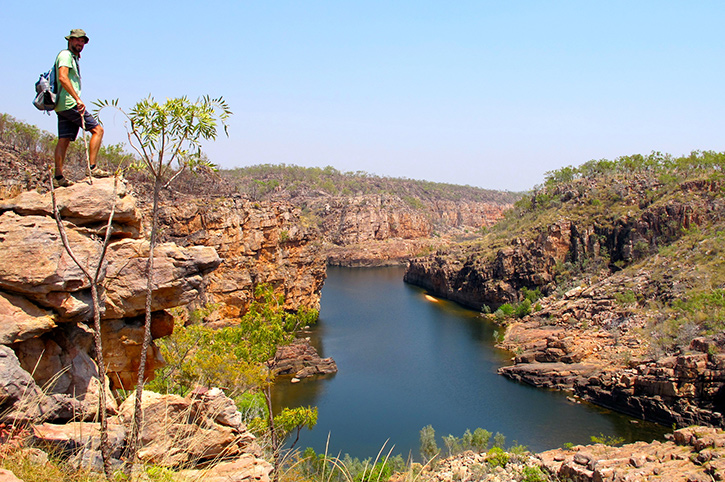
Road trips don’t get much more epic than in Australia. In a country so big, that it is also a continent, there are plenty of open roads to explore, big skies to admire and panoramic landscapes to view. It will take at least 3 months to complete “The Big Lap” and circumnavigate the whole of Australia, but you don’t need to travel that far to escape on an Australian holiday. Here are five shorter road-trips to help you escape on an Australian Road Trip.
To drive from Sydney to the Great Barrier Reef is to connect two of Australia’s icons with a route along two of Australia’s longest roads.

From Sydney you can follow the The Pacific Highway to Newcastle, before heading inland to the Hunter Valley; Australia’s oldest wine producing region and a picturesque area to get away from the crowds. Further along the road (and remember all distances in Australia are large) you will come to the laid-back area of Byron Bay. Blessed with beautiful beaches, Byron Bay draws tourists, surfers and those seeking an alternative lifestyle, but it is also an important conservation area and from the headland next to the historic lighthouse it is possible to see Humpback Whales migrate along the coast.
The glamour of the Gold Coast and Surfers Paradise are a hop up the coast from Byron Bay and then you can head on to Queensland’s capital city of Brisbane. Life in Brisbane is all about the outdoors, so expect to shop, eat and explore the city in the warm tropical air. You can also get your wildlife fix from Brisbane by visiting the famous Australia Zoo or the lesser-known Moreton Island.

North of Brisbane you are on the Bruce Highway and you will soon reach Noosa and the incredible K’gari (formerly Fraser Island). From Noosa you can cruise the mangroves and wetlands, but everyone should visit the sands of K’gari. This World Heritage listed island is famous for being the world’s largest sand island, but less well known are the tall rainforests and freshwater lakes that inhabit the dunes.
The limestone scenery provides a good turn-off along the Bruce Highway at the Capricorn Caves, before continuing to Airlie Beach; the gateway to the beautiful Whitsunday Islands. The islands are as close to an image of paradise as you can dream of, so you should spend some time on a boat cruise to see this with your own eyes.

The further north you journey into Queensland the more the Great Barrier Reef begins to dominate. Townsville hosts the Reef HQ; a living coral aquarium, Mission Beach hosts a reef market and Port Douglas marks the gateway to the reef. Of course, the town of Cairns is synonymous with the Great Barrier Reef, and it is here that you can cruise the reef, fly over the reef or dive down to the reef. The choices are endless. There can be no better place to stop and relax at the end of this legendary road trip.
The people tasked with naming this stretch of the B100 road didn’t have a difficult job. Great views of the Southern Ocean from the winding coast road.

Officially recognised by Australian National Heritage, the Great Ocean Road officially begins just south of the city of Melbourne at Torquay. Torquay (much like its British namesake) is also widely recognised as the surf-capital of Australia and just along the coast is Bell’s Beach where professional surfers can be seen riding the impressive waves.
The stretch of road from the town of Lorne to Apollo Bay follows the headlands and inlets, always keeping the sea close-by. The panoramic view, unbroken by buildings or trees, makes this stretch of the Great Ocean Road perfect for those wanting to cruise along and take in the magnificent scenery.
Beyond Apollo Bay and the Great Otway National Park, you reach the most recognisable and iconic view from the Great Ocean Road. The Twelve Apostles are limestone pillars that stand proudly off the cliffs. The powerful waves and strong winds carved the rocks and these stacks are all that remains of that slowly eroding coast. The scenery is constantly evolving and at the time of writing there are only eight “apostles” standing. Don’t walk too close to the edge as nobody can predict when the ninth “apostle” may be added!

The road continues along the coast to the town of Warrnambool; a good spot for watching for whales as they migrate along the coast. The town also marks the official western end of the Great Ocean Road; however, it would be a mistake to end the road trip here.
The town of Mount Gambier is a great base for exploring further natural features created by the limestone scenery of the area. The sapphire waters of Blue Lake are a must see and the underground garden of Umpherston Sinkhole and the clear waters of Piccaninnie Ponds are worth a detour from the road.

The picturesque coastal town of Robe is calm and quiet in the winter but come the summer holiday season it bursts into life as a bustling seaside hotspot. It is difficult to criticize the tourists for coming as the 14km long sandy beach and the cool waters are very attractive. The local ale from Robe Town Brewery isn’t bad either!
Continuing along the South Australian coast on the B1 road, takes you through Coorong National Park. This relatively flat wetland area hosts a chain of saltwater lagoons and sand dunes that stretch for a mammoth 130 kilometres.

Ending this great Australian Road Trip in Adelaide enables you to explore the City of Churches or venture on to the Barossa Valley to sample some of the product from the famous wineries such as Penfolds, Wolf Blass and Yalumba.
Stretching 1200 kilometres up the west coast from Perth to Exmouth, the Coral Coast Highway (or Indian Ocean Drive as it is also known) provides irresistible opportunities to explore untouched landscapes and interact with unique wildlife in their own habitat. Driving Northbound to Ningaloo Reef you will soon leave the city of Perth behind and find yourself surrounded by endless horizons and monumental experiences.

Before beginning your road trip be sure to visit Rottnest Island; a short ferry ride from Perth. As well as phenomenal beaches and coastal scenery, the island is home to the very friendly Quokka. These rare marsupials are more than happy pose for a selfie as you explore the island.
Near to the seaside town of Cervantes (about 200km north of Perth) is the unforgettable Nambung National Park; home of The Pinnacles. These natural limestone structures were originally formed 30,000 years ago and have since been carved by the prevailing winds and desert sands to leave a forest of stone pillars protruding from the dunes. The views of these natural obelisks are heightened as the sun goes down and the shadows lengthen.

Just beyond the pink lake of Hutt Lagoon, Kalbarri National Park takes epic landscapes to a grander scale. Not only does Kalbarri provide sandy beaches and high sea cliffs with spectacular views of the ocean, but just a little further inland, the Murchison River has created breathtaking gorges into the rocks. Particularly memorable is Nature’s Window; a remarkable natural arch, framing the steep canyon below.
The deserted beaches and coves of Shark Bay are a protected World Heritage Area and provide perfect photo opportunities as the road trip continues north. The resort of Monkey Mia provides the perfect location to relax and enjoy calm seas and perfect beaches, but it is also a great place to interact with the wildlife. Whilst out walking you may encounter emus, echidnas, kangaroos, and basking reptiles, but the highlight will definitely be an encounter with the wild dolphins who choose to visit the resort on an almost daily basis.

Exmouth makes the end of this West Australia road trip, but it doesn’t flag the end of the experiences. Exmouth is the gateway to the Ningaloo Reef. The spectacular coral is perfect for novice snorkelers and experienced divers who can spot the Big 3 of whale sharks, humpback whales and manta rays in the area.
Australia is such a large country, that the Northern Territory is often missed on journeys further south. This is a pity, because this Top End Tour provides a perfect example of all the stunning nature that outback Australia has to offer. The road trip keeps to quiet roads providing access to remote wilderness and some of Australia’s best National Parks.

Before heading off on this road trip, it worth taking some time to explore the city of Darwin and in particular the waterfront area that is home to restaurants, cafes and bars as well as a saltwater lagoon. For a view from the water, head to Stokes Hill Wharf, where harbour boat tours depart. Particularly popular are the tropical sunset cruises.
Heading out of Darwin on the Arnhem Highway, you quickly become aware of the space that surrounds you. On your route east it is possible to stop at the Adelaide River to visit the wetlands visitor centre to learn more about the abundant wildlife that you may spot along the way.

The next stop is Jabiru in Kakadu National Park, where you should take a few days to explore this ancient and untouched environment. The unique flora and fauna are augmented by the unusual rock formations and ever-changing waterways. From Jabiru it is a 40 kilometre drive to Ubirr Rock, where it is possible to view ancient artwork and carvings estimated to be up to 20,000 years old. The views from the top of the rock reveal nearby billabongs and wetlands along the East Alligator River.

Heading further into the outback, along the Stuart Highway will bring you to Katherine Gorge. This area is made famous by the river system which features a total of 13 gorges all joined by white water rapids and waterfalls. It is possible to take a short cruise through some of the gorges, or even a scenic flight above Katherine to get a bird’s eye view. As this is a road tip you may also like to drive a further 110km to Mataranka thermal pools that are located within the Elsey National Park. These naturally heated pools here are kept at 34 degrees centigrade, making them very popular for bathers.
Self drives with hotels and car hire included.


Launceston | Coles Bay | Freycinet National Park | Port Arthur | Hobart


Apollo Bay | Port Fairy | Robe | Barossa Valley | Adelaide


Sydney | Hunter Valley | Port Stephens | Byron Bay | Brisbane | Sunshine Coast | K’gari | Rockhampton | Whitsundays | Cairns


Launceston | Coles Bay | Freycinet National Park | Port Arthur | Hobart


Apollo Bay | Port Fairy | Robe | Barossa Valley | Adelaide


Sydney | Hunter Valley | Port Stephens | Byron Bay | Brisbane | Sunshine Coast | K’gari | Rockhampton | Whitsundays | Cairns
From Katherine change direction and start heading north again. This time stay on the Stuart Highway to visit Litchfield National Park. Beautiful waterfalls and waterholes dominate the park and are relatively easily accessible from the main highway. The natural spa of Buley Rockhole and Florence Falls provide bathing opportunities and a chance to escape the midday heat.

Further along the road, it is possible to witness large magnetic termite mounds that stretch up to 6 feet high. There are boardwalks in place so you can get close without disturbing some of nature’s miracle workers. If you ned to cool down further on the way back into Darwin then you can either stop at Berry Springs for a swim in the pristine waters, or stop at a mango farm for a fresh drink or ice-cream.
Lush green mountains and deep blue lakes are the perfect backdrop to this road trip that circumnavigates the island of Tasmania. There are plenty of opportunities to stretch your legs along the way and to get up close to some of the unique wildlife on the Around Tasmania self-drive.

Overlooked by Mount Wellington and built around a beautiful harbour, Hobart is a small city with a growing reputation for art and culture. It is worth spending some time in Salamanca Place where rows of Georgian buildings have been converted into galleries, restaurants and high-end retail outlets.
Starting out on the spectacular Lyell Highway, cross the Franklin-Gordon National Park on the way to the town of Strahan on the far west coast of Tasmania. The road through the park offers views of spectacular peaks, deep gorges, wild moorlands, still lakes and plenty of walking trails to get out amongst the scenery if you wish.

From Strahan the road enters the Cradle Mountain-Lake St. Clair National Park. Cradle Mountain is synonymous with nature, wilderness, and wildlife. In fact, it is one of the few places that you can hope to spot Tasmanian devils, echidna, platypus and wombats all in one place. The roads through the park are lined by deep, moss-covered forests that hide lakes, rivers and waterfalls beyond. It is possible to hike to the summit of Cradle Mountain where you can see across most of the island, but for those preferring a gentler walk, it is possible to walk around Dove Lake and the Ballroom Forest with views of the mountain above.

The road from Cradle Mountain to Launceston starts in the mountains and drops down to lower hills, covered in grasslands, but the views keep coming. Be sure to stop at Marakoopa Cave, that features underground streams and an impressive glow-worm display.
From Launceston head for the coast and the bay-side town of St. Helens. Along the way stop at Pyengana to walk to St. Columba Falls. Then, once at St. Helens, choose to either explore the beaches of the Bay of Fires or relax and dine on the locally caught seafood.

The Tasman Highway heads south, however be sure to turn off to visit the remote Freycinet National Park, home of some of Tasmania’s most beautiful scenery. It is possible to view some of the more inaccessible parts of the park by boat but visiting Honeymoon Bay and then hiking to Wineglass Bay are unmissable experiences.
“We all want to escape sometimes.” says Amber; one of Freedom Destinations’ Australia Travel Specialists. “Australia has the epic road trips that enable you to discover nature at its biggest and best. Often you don’t have to go far outside the cities to feel away from everyone and out in the bush. I particularly enjoyed driving up the Coral Coast Highway in Western Australia. The combination of rock features and wildlife experiences is something I will remember forever.”
The Australian Outback is not somewhere to venture alone or without a carefully planned itinerary. Freedom Destinations’ Australia Team have the knowledge and experience to help you plan your next Australian road trip.
Richard has more than 25 years of experience working within the travel industry. He has travelled widely in Europe, the USA & Canada, Australia & New Zealand, South East Asia, as well as Southern Africa. He enjoys exploring National Parks and other wilderness areas.